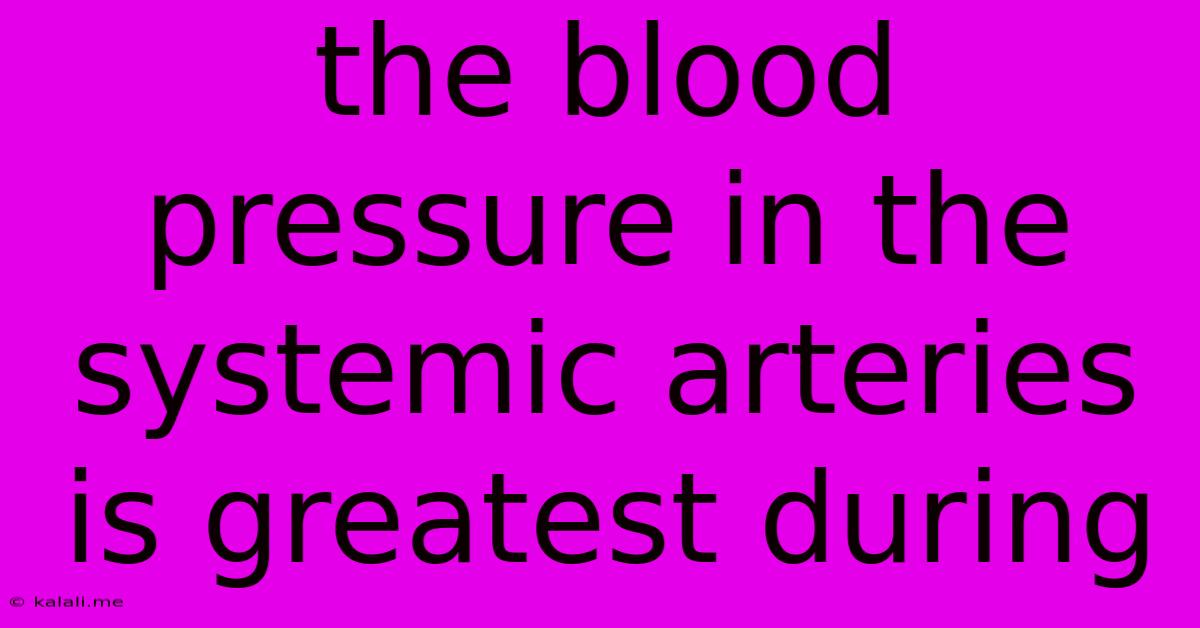The Blood Pressure In The Systemic Arteries Is Greatest During
Kalali
May 10, 2025 · 3 min read

Table of Contents
The Blood Pressure in the Systemic Arteries is Greatest During Systole: A Deep Dive into Cardiac Mechanics
The pressure within the systemic arteries fluctuates constantly, driven by the rhythmic contractions of the heart. Understanding this pressure variation is crucial for comprehending cardiovascular health and disease. This article will explore why blood pressure in the systemic arteries is greatest during systole, the contraction phase of the cardiac cycle.
What is Systemic Arterial Blood Pressure?
Systemic arterial blood pressure refers to the force exerted by blood against the walls of the arteries as it circulates throughout the body, excluding the pulmonary circulation. It's measured as two numbers: systolic and diastolic pressure. Systolic pressure represents the peak pressure during ventricular contraction, while diastolic pressure reflects the minimum pressure during ventricular relaxation. Maintaining healthy blood pressure is vital for overall well-being, as sustained high blood pressure (hypertension) increases the risk of various health problems, including stroke, heart attack, and kidney disease.
The Cardiac Cycle and Blood Pressure Fluctuation
The heart's rhythmic beating, the cardiac cycle, is responsible for the pulsatile nature of blood pressure. The cycle consists of two main phases:
- Systole: The phase where the ventricles contract, forcefully ejecting blood into the aorta and pulmonary artery. This ejection creates a surge of blood into the arterial system, causing a rapid increase in pressure. This is the point of highest blood pressure within the arteries.
- Diastole: The phase where the ventricles relax and refill with blood. During diastole, the pressure in the arteries gradually decreases as blood flows into the smaller arterioles and capillaries. This is the point of lowest blood pressure within the arteries.
Why is Systolic Pressure Higher?
The significantly higher pressure during systole is a direct consequence of the forceful ejection of blood from the left ventricle into the aorta. Several factors contribute to this elevated pressure:
- Ventricular Contraction Strength: The stronger the ventricular contraction, the greater the volume of blood ejected, leading to a higher systolic pressure. This strength is influenced by factors such as preload (volume of blood in the ventricle before contraction), afterload (resistance to blood ejection from the ventricle), and contractility (intrinsic ability of the heart muscle to contract).
- Aortic Valve Opening: The opening of the aortic valve allows a rapid flow of blood into the aorta, further contributing to the pressure surge. Any stenosis (narrowing) of the aortic valve can impair this flow and consequently affect systolic pressure.
- Arterial Elasticity: The elastic properties of the large arteries (like the aorta) play a crucial role in buffering the pressure surge during systole. These arteries expand to accommodate the increased blood volume, minimizing the peak pressure. Loss of elasticity (arteriosclerosis) can lead to higher systolic pressures.
- Blood Volume: The total volume of blood circulating within the cardiovascular system also influences blood pressure. Increased blood volume generally results in higher pressures, both systolic and diastolic.
Clinical Significance and Monitoring
Understanding the relationship between the cardiac cycle and systemic arterial blood pressure is crucial for diagnosing and managing cardiovascular diseases. Regular blood pressure monitoring helps identify hypertension early, allowing for timely intervention to reduce the risk of complications. The measurement of systolic and diastolic pressures provides valuable information about the heart's pumping efficiency and the overall health of the circulatory system. Accurate assessment of these pressures, along with other clinical indicators, is vital for the diagnosis and management of cardiovascular conditions.
In conclusion, the blood pressure in the systemic arteries reaches its highest point during systole due to the powerful ejection of blood from the left ventricle into the arterial system. The interplay of ventricular contraction strength, aortic valve function, arterial elasticity, and blood volume all contribute to this peak pressure. Understanding this physiological process is fundamental to comprehending cardiovascular health and managing associated diseases.
Latest Posts
Related Post
Thank you for visiting our website which covers about The Blood Pressure In The Systemic Arteries Is Greatest During . We hope the information provided has been useful to you. Feel free to contact us if you have any questions or need further assistance. See you next time and don't miss to bookmark.